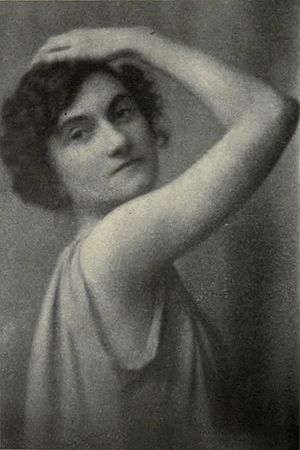Marion Morgan (choreographer) facts for kids
Quick facts for kids
Marion Morgan
|
|
|---|---|

Morgan in 1917
|
|
| Born |
Marion R. Cahill
January 4, 1881 Paterson, New Jersey, U.S.
|
| Died | November 10, 1971 (aged 90) Los Angeles, California, U.S.
|
| Burial place | Forest Lawn Memorial Park (Glendale), U.S. |
| Occupation | Choreographer |
| Partner(s) | Matthew A. Morgan (m. 1900–div. 1905) Dorothy Arzner (1927–1971) |
| Children | Roderick D. Morgan (1901–1929) |
| Parent(s) | John F. Cahill (father) Emily Cahill (mother) |
Marion Morgan (born January 4, 1881 – died November 10, 1971) was an American choreographer and a writer for movies. She was also a close friend and creative partner of movie director Dorothy Arzner. They lived together for the last 40 years of Morgan's life.
Contents
Early Life and Dance Career
Marion R. Cahill was born in Paterson, New Jersey, on January 4, 1881. Her parents were Emily and John F. Cahill. Her father was a lawyer. In 1900, she married Matthew A. Morgan. They had a son named Roderick the next year. By 1905, they had separated.
Around 1910, Marion and her son moved to Long Beach, California. She worked as a physical education teacher at Manual Arts High School in Los Angeles. Later, she became a dance instructor for a summer program. This was at the University of California, Berkeley.
Forming a Dance Troupe
While teaching, Marion started looking for girls to join a dance group. This group would perform in vaudeville shows. Vaudeville was a popular type of entertainment with many different acts. Her group performed on the Orpheum Circuit. In 1915, she even staged a dance in the snow. This was in Manhattan's Central Park to get attention.
At first, Morgan's group had six young women. They had all studied dance in California. The group grew to include up to twenty-five members. Sometimes, they would also have a male dancer. They performed "interpretive dances." These dances told stories or showed feelings. The dancers wore light, flowing costumes. They often danced with bare arms and sometimes bare feet. Their performances were based on themes from ancient Egypt, Greece, and Rome.
Dancer Requirements and Success
Marion Morgan had strict rules for her dancers. They had to stay very fit. All of them were required to be vegetarians. At one point, they all practiced Christian Science. They also had to study classic literature. This helped them understand their dance roles better.
The group traveled all over the country. They became very popular wherever they performed. In 1921, Morgan met Dorothy Arzner. This happened on the movie set of Man-Woman-Marriage. Arzner was a director. This meeting began a strong friendship and working relationship.
After more than ten years of vaudeville shows, Morgan started creating dances for movies. One of her first movie projects was Paris at Midnight in 1926. She also choreographed dances for other films. These included A Night of Love (1926) and The Masked Woman (1927). Her dance group, the Marion Morgan Dancers, performed in these movies. They also appeared in Up in Mabel’s Room (1926).
Working with Dorothy Arzner
Arzner and Morgan first worked together on a movie in 1927. It was called Fashions for Women. This was Arzner's first movie as a director. She hired Morgan to create the dances for a fashion show scene. In the same year, Morgan created a special scene for Arzner's movie Get Your Man. It showed her dancers in a wax museum. The magazine Variety said this was the best part of the film.
In 1928, they worked together again on Manhattan Cocktail. Morgan choreographed the opening part of the movie. It told the story of Ariadne and Theseus. Her dancers had performed this story on stage before. In 1930, Morgan and Arzner moved into a house together. They called it "Armor." This name was a playful nod to "Pickfair," the famous home of Mary Pickford and Douglas Fairbanks. Their house was on Mountain Oak Drive in the Hollywood Hills.
Later Years and Writing
During the 1930s, Morgan often traveled. She visited the East Coast and Europe. In 1934, she graduated from the Yale School of Drama. In the mid-1930s, Morgan started writing short stories. She worked with George B. Dowell. They also wrote movie scripts together. The famous actress Mae West helped them write Goin' to Town (1935) and Klondike Annie (1936). In 1951, Morgan and Arzner moved to the desert in Palm Springs. They lived there until Morgan passed away.
Death and Legacy
Marion Morgan died on November 10, 1971, in Los Angeles. She is buried at Forest Lawn Memorial Park (Glendale). Her son, Roderick D. Morgan, is buried there with her.
Her dance records and materials are kept safe. They are at the Jerome Robbins Dance Division. This is part of the New York Public Library for the Performing Arts.
Images for kids


